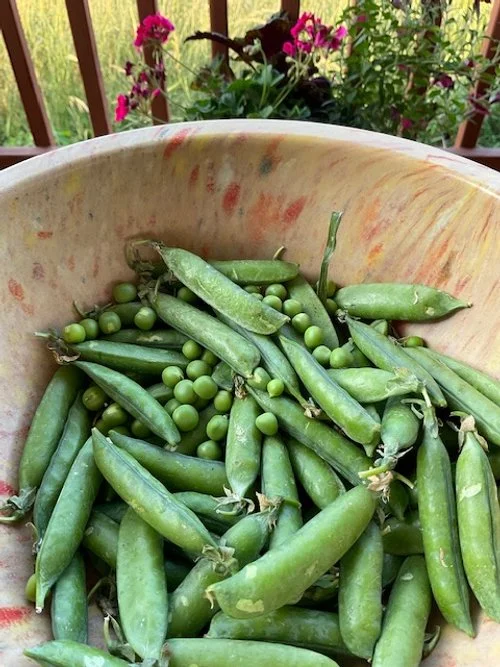Shelling Peas
On Sunday at market as one of the produce vendors was putting out their vegetables in the little green cardboard containers I snatched a pea pod and began opening it to sample the little green nuggets held inside.
“You don’t have to do that.” I was told they are snap peas and you can eat the whole thing. And so I popped the whole thing into my mouth and went about my business. At the end of the market there were several containers of peas pods still left on their table and I decided that my cooking this week would entail some of those wonderful peas. As I picked up the containers I was warned those are the ones you have to shell.
I’m no stranger to shelling peas although I do enjoy the convenience of purchasing them freshly shelled or being able to eat the entire pod. Frozen peas might do in a pinch and canned peas are persona non grata in my pantry, but I’m all about those fresh peas! The farmer handed me a few boxes and away I went.
After the trip home, unloading, unpacking, doing the evening farm chores, and taking out the trash, I settled on to my front porch with an adult beverage. There I sat winding down from the day, listening to the birds song, watching the animals graze on pasture as the day waned toward dusk, and shelled peas.
Shelling peas was always something I enjoy doing whether it was with my neighbors, the elderly couple who kindly took me under their wing when I first moved back east and purchased a farm. We would sit in their garage, three brothers and their wives who had all lived on the same street for over 50 years, each with a huge garden growing something different so they could share among the family. Everyone would get a 5 gallon bucket and a bowl for the shelled peas. In the center of the chairs was a large 25 gallon stock tank into which the shells were collectively deposited to be then tossed to the chickens as a treat. We would sit for a few hours on an early summer evening visiting and passing the time. “Many hands make light work,” is what Sarah would always say thanking me with a container of freshly shelled peas as I headed home.
There were pea shelling sessions among my own family when grandma was still alive. We would go over the mountain to see her people and end up shelling peas
Once I was buying produce at a local farm stand not far from my home and I noticed they had a contraption that shelled and washed the peas at the same time. I was tempted to grow myself a mess of peas and have them shelled in the machine, but the lady said they only did that for family members. It wasn’t a business.
Although we consider peas a vegetable, they are actually a fruit and the shelled peas are the seeds of the fruiting body.
Peas were some of the first foods cultivated when humans began practicing agriculture around ten thousand years ago. Today they are grown and eating throughout the world.
There are also many types of peas. Snap peas and snow peas have tender pods and smaller seeds, often eaten whole. Sweet peas have thicker pods with a tough string that gets pulled from the end where the pod attaches to the plant. Once removed, the pod opens like a coin purse to expose the swollen spherical seeds, what we commonly refer to as green peas.
Sweet peas can also be left on the plant to dry prior to harvest, similar to beans. These are the types of peas used in dishes like split pea soup. What about black-eyed peas, Crowder peas, and cow peas? Fake peas! They are actually beans.
There are so many ways to used peas in cooking. They can be used raw in salads. Babies are often fed pureed peas as one of their first foods since peas are high in both sugar and carbohydrates. My go-to fresh pea dish is to toss them with hot pasta, olive oil, black pepper, and a flavorful hard cheese—all things you can find at the market.
This week when you see peas at the market, consider getting sweet peas that need shelling and sit a spell with someone you love while shelling peas together. They’re worth way more than a great meal.

